 Pirates and Privateers Pirates and Privateers
The History of Maritime
Piracy
Cindy Vallar, Editor
& Reviewer
P.O. Box 425,
Keller, TX 76244-0425
    
Pirates and
Death
by Cindy Vallar
Perhaps Bartholomew
Roberts best summed up a pirate’s life while
speaking to new recruits forced to join his crew:
In an
honest Service there is thin Commons, low Wages,
and hard Labour; in this, Plenty and Saiety,
Pleasure and Ease, Liberty and Power; and who
would not ballance Creditor on this Side, when
all the Hazard that is run for it, at worst, is
only a sower Look or two at choaking. No, a
merry Life and a short one, shall be my Motto.
(Defoe, 244)
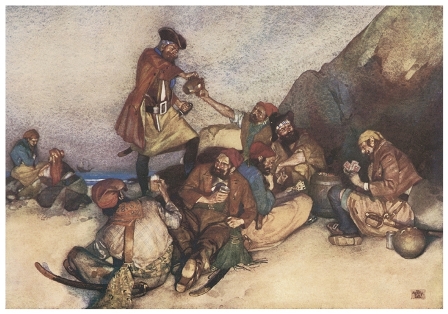 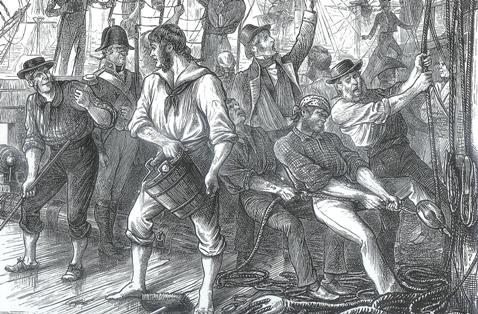
Pirate life versus navy life
(Source: Dover)
As Marcus
Rediker explained in the introduction to Between
the Devil and the Deep Blue Sea, “[t]he
omnipotence of the elements and the fragility of
human life marked the consciousness of every
early-eighteenth-century seaman.” (2) They lived
with death every day, not just from nature, but also
from the work they did. Many pirates initially came
from this legitimate maritime world and were all too
familiar with the hazards seamen encountered. Rather
than heed orders from the master of a ship, they
preferred to sail aboard a vessel where they were
masters of their fates – at least as much as Mother
Nature permitted. This was why Roberts preferred to
enjoy life for as long as he was able. As with most
choices, his had a consequence that proved fatal.
Sailing on a wooden ship was similar to running the
gauntlet. Rather than enduring strikes from clubs,
swords, or other items that inflicted pain, seamen
encountered churning seas, sudden squalls,
hurricanes, waterspouts, or any number of other
tempests at Mother Nature’s disposal, including
unseen shoals and reefs that could wreck the ship.
Then there were the inevitable problems that
resulted from poor maintenance, such as a leaky
hull, and the inherent dangers of working on a ship.
[T]he
chances of a seaman ending his life in . . . a
catastrophe were high, and many a man fell from
the rigging, was washed overboard, or was
fatally struck by falling gear. (Rediker,
Between, 92-93)
Ship explosion and waterspouts
One such catastrophe occurred on 2 January 1669. Henry
Morgan summoned the buccaneer captains to
gather at Île à Vache to plot out another raid on
Spanish America. They chose Cartagena
as their next target, and fifteen guns were fired to
announce their destination to the rest of the
pirates. Then the captains, including Morgan, dined
on the flagship’s quarterdeck. Richard Browne, a surgeon,
later wrote:
But
about 12 o’clock . . . the Oxford
blew up and above 200 men lost . . . There were
but six men and four boys that belonged to the
Oxford saved . . . and eight more that were
aboard the French prize, some few a-hunting, and
others washing their clothes ashore. It cannot
be imagined how this sad accident happened, but
suppose the negligence of the gunner in filling
powder to load the guns . . . At the time of the
blowing up the ship, Captain Whiting, the
purser, and myself were at dinner at the
binnacle . . . The mainmast jumped up out of the
ship and fell upon the starboard quarter, where
Captain Aylett, Captain Bigford, and some other
Captains were walking and were all knocked on
the head by the mainmast, and Captain Whiting,
who was on my right hand and the purser on my
left, and was out-angled in the awning and so
drowned. . . . I only heard a great rushing
noise, with fire and smoke, and the battlements
of the awning being on fire fell upon me, and
immediately I felt the deck give way and was in
the water over head and dived, and presently
bore up again and saved myself by getting
astride upon the mizzenmast. There were not
above 20 persons . . . from other ships and our
own company that were saved, and most of them
much hurt. All them that were upon deck or any
part of the ship, were all lost, except those
upon the quarter-deck. (Marley, Pirates,
1:427-428)
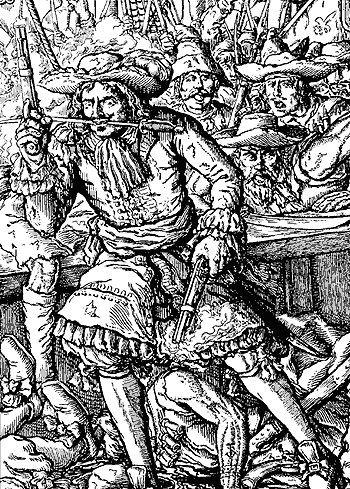 Other times Mother Nature, rather
than human error, caused the accidental deaths of
men. While traversing the Darien
jungle with other buccaneers in 1681, George Gainy
(Gayny) drowned when he attempted to cross a river
with a bag containing 300 Spanish silver dollars
draped around his neck. Lionel
Wafer, one of the surgeons on the expedition,
discovered his body after it finally washed ashore
in a creek. That same year, John Alexander went
under while transporting tools to the island of
Chira. It took three days to find the body of this
Scot, who sailed with Bartholomew
Sharp. The next day, the buccaneers “threw him
overboard, giving him three French vollies for his
customary ceremony.” (Gosse, 28) Henry Sherral
(Shergall) fell into the sea from the spritsail-top
of Sharp’s ship near Cape Horn in October 1681,
never to be seen again. Edward Church and a man
named Atwell (Atwill), who sailed with Charles
Gibbs, drowned off the coast of Rhode Island
in 1831. The circumstances surrounding their deaths
weren’t recorded, but they were far from the only
pirates who died mysteriously while at sea. The best
leader of the flibustiers from France, le Chevalier
de Grammont, and nearly 200 men perished
during a storm in 1686. Swept overboard in dirty
weather, Captain Stephen Heynes, whose brutal
torture techniques caused his own crew to beg him to
stop, lost his life in 1582. Zheng Yi
(Cheng I) went overboard during a storm in 1807, at
the height of his power as leader of a confederation
of Chinese pirates. Other times Mother Nature, rather
than human error, caused the accidental deaths of
men. While traversing the Darien
jungle with other buccaneers in 1681, George Gainy
(Gayny) drowned when he attempted to cross a river
with a bag containing 300 Spanish silver dollars
draped around his neck. Lionel
Wafer, one of the surgeons on the expedition,
discovered his body after it finally washed ashore
in a creek. That same year, John Alexander went
under while transporting tools to the island of
Chira. It took three days to find the body of this
Scot, who sailed with Bartholomew
Sharp. The next day, the buccaneers “threw him
overboard, giving him three French vollies for his
customary ceremony.” (Gosse, 28) Henry Sherral
(Shergall) fell into the sea from the spritsail-top
of Sharp’s ship near Cape Horn in October 1681,
never to be seen again. Edward Church and a man
named Atwell (Atwill), who sailed with Charles
Gibbs, drowned off the coast of Rhode Island
in 1831. The circumstances surrounding their deaths
weren’t recorded, but they were far from the only
pirates who died mysteriously while at sea. The best
leader of the flibustiers from France, le Chevalier
de Grammont, and nearly 200 men perished
during a storm in 1686. Swept overboard in dirty
weather, Captain Stephen Heynes, whose brutal
torture techniques caused his own crew to beg him to
stop, lost his life in 1582. Zheng Yi
(Cheng I) went overboard during a storm in 1807, at
the height of his power as leader of a confederation
of Chinese pirates.
Benjamin
Hornigold, who taught many others the fine art
of piracy, took the King’s Grace and became a pirate
hunter. On one voyage to capture rogues who refused
to change their ways, his ship struck a reef and he
drowned.1 The
most legendary of the pirate shipwrecks was the Whydah,
and her captain, Samuel
Bellamy, was once a protégé of
Hornigold’s.
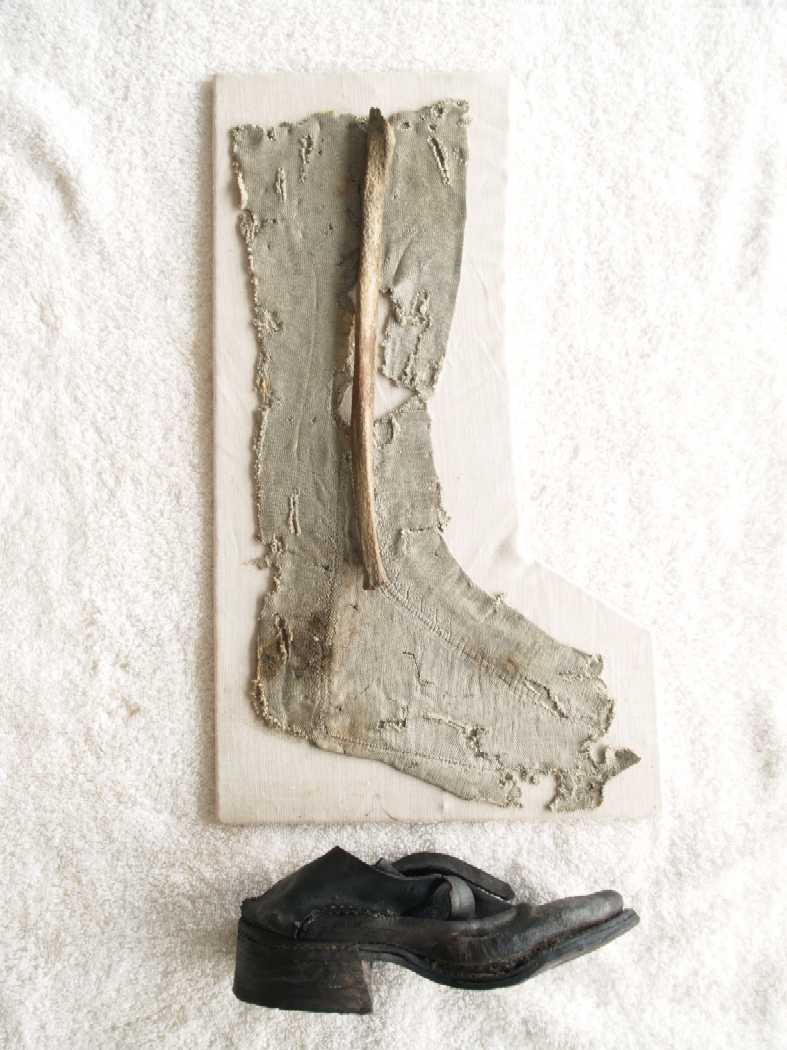 The Whydah
began a slow turn toward the wind, taking
thousands of tons of water over the gunwales as
she was swept by forty-foot waves. Many of the
148 men on board must have been swept over the
side at this point. The ones who weren’t had
probably taken refuge in the hold or were
clinging desperately to the rigging, where the
wind was colder than the forty-degree water. The Whydah
began a slow turn toward the wind, taking
thousands of tons of water over the gunwales as
she was swept by forty-foot waves. Many of the
148 men on board must have been swept over the
side at this point. The ones who weren’t had
probably taken refuge in the hold or were
clinging desperately to the rigging, where the
wind was colder than the forty-degree water.
Still the ship
turned. . . . Then came the fateful bump that
meant the stern had run aground and the ship
could turn no more. More water swept the deck,
filling the holds and slowly rolling the ship.
Within fifteen minutes of striking land, the
mainmast was snapped off and floated free. Then,
with nothing left to keep her upright, the ship
began to roll upside down. Pirates were crushed
as cannons and goods stored below came crashing
through the decks. Those who could, swam, but in
water so cold, there were few who could make it
the five hundred feet to shore. Those who did
froze to death trying to climb the steep sand
cliffs of Eastham. (Clifford, Expedition,
265)
One hundred thirty
pirates lost their lives that night off the coast of
Cape Cod on 26 April 1717, including Bellamy. A
cannon pinned the youngest
member of the crew, John King,
to the ocean floor. Centuries later, after Barry
Clifford discovered the remains of the wreck, all
that remained of the nine year old was a fragment of
leg bone, concealed in the same silk stocking he had
worn the day Bellamy captured the ship John sailed
on with his mother, and his leather shoe still
fastened with its buckle.
In spite of all these potentially fatal threats,
other more pervasive dangers claimed the lives of
more pirates and seamen than any other cause of
death. When Commodore George
Anson left Portsmouth in 1740, 1,995 men
served aboard the seven naval ships. Four years
later on his return, he had only one ship and 145
men. More than 53% of his contingent had died from
illness, particularly scurvy.2 During
the Seven
Years’ War, 1,500 men in the Royal Navy were
killed in action, whereas almost 15,000 succumbed to
disease.
 Before
Francis
Drake captured the mules laden with treasure
bound for Nombre de
Dios (1572), his brother Joseph died in his
arms from an epidemic that swept through his crew.
Francis demanded the surgeon perform an autopsy to
determine the cause of death in hopes of saving
others afflicted with the malady. Joseph’s liver was
swollen and his heart “sodden,” but before the
surgeon gave his diagnosis, he succumbed also.
Period documents identified the disease
as calenture – delirium, fever, and sunstroke – but
yellow fever was a likely culprit. Sir Francis would
also die of an illness, dysentery, while on his last
voyage in 1596. John Ward
(Yusuf Reis) died of the plague in 1623, in his
adopted homeland of Tunis, where he had lived since
becoming a renegado and joining the Barbary
corsairs. William Cammock, one of Bartholomew
Sharp’s buccaneers, imbibed so much while at La
Serena that he contracted a malignant fever and
hiccoughs, which killed him in 1679/1680. Captain
John Cooke (Cook) fell ill and died in 1684. This
buccaneer, who also sailed with Sharp as well as
Charles Swan, was laid to rest ashore at Cape
Blanco, Mexico. Another cohort of Sharp’s was his
chief mate, John Hilliard, who became a victim of
dropsy in 1681. Sharp recorded in his journal the
death of another of his crew in January 1682.
William Stephens (Stevens) “was observed, after his
eating of three Manchaneel
Apples, at King Charles’ Harbour, to waste
away strangely, till at length he was become a
perfect skeleton.” (Downie, 218) “Next morning we
threw overboard our dead man and gave him two French
vollies and one English one.” (Gosse, 218) Before
Francis
Drake captured the mules laden with treasure
bound for Nombre de
Dios (1572), his brother Joseph died in his
arms from an epidemic that swept through his crew.
Francis demanded the surgeon perform an autopsy to
determine the cause of death in hopes of saving
others afflicted with the malady. Joseph’s liver was
swollen and his heart “sodden,” but before the
surgeon gave his diagnosis, he succumbed also.
Period documents identified the disease
as calenture – delirium, fever, and sunstroke – but
yellow fever was a likely culprit. Sir Francis would
also die of an illness, dysentery, while on his last
voyage in 1596. John Ward
(Yusuf Reis) died of the plague in 1623, in his
adopted homeland of Tunis, where he had lived since
becoming a renegado and joining the Barbary
corsairs. William Cammock, one of Bartholomew
Sharp’s buccaneers, imbibed so much while at La
Serena that he contracted a malignant fever and
hiccoughs, which killed him in 1679/1680. Captain
John Cooke (Cook) fell ill and died in 1684. This
buccaneer, who also sailed with Sharp as well as
Charles Swan, was laid to rest ashore at Cape
Blanco, Mexico. Another cohort of Sharp’s was his
chief mate, John Hilliard, who became a victim of
dropsy in 1681. Sharp recorded in his journal the
death of another of his crew in January 1682.
William Stephens (Stevens) “was observed, after his
eating of three Manchaneel
Apples, at King Charles’ Harbour, to waste
away strangely, till at length he was become a
perfect skeleton.” (Downie, 218) “Next morning we
threw overboard our dead man and gave him two French
vollies and one English one.” (Gosse, 218)
Captain John Halsey
succumbed from a tropical fever in 1716. One of
those present at the burial described his funeral:
With
great solemnity, the prayers of the Church of
England being read over him and his sword and
pistols laid on his coffin, which was covered
with a ship’s Jack. As many minute guns were
fired as he was old – viz, forty-six – and three
English vollies and one French volley of small
arms. His grave was made in a garden of
watermelons and fenced in to prevent his being
rooted up by wild pigs. (Gosse, 150)
Perhaps the more famous
of the pirates who died from disease was Mary Read,
who sailed with John
“Calico Jack” Rackham. Although she was
convicted of piracy, she was given a stay of
execution because she was pregnant. While in jail,
she “was seiz’d with a violent Fever, soon after
their Tryal, of which she died in Prison.” (Eastman,
40) According to Saint Catherine Parish Records, she
died on 28 April 1721, and was buried in the
Jamaican church’s cemetery.
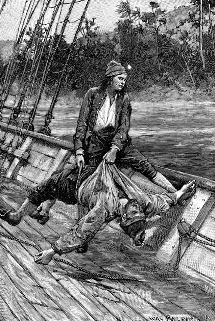 Depending on the
circumstances, pirates might or might not take time
to honor their fallen comrades. If in the midst of
battle, bodies might be tossed over the side.
Otherwise they performed simple ceremonies as soon
as time permitted since pirates, like other seamen,
preferred not to have corpses on their ships.
Preserving bodies involved the use of alcohol, and
pirates weren’t likely to waste good spirits on the
dead.3 Prior
to burial the deceased was placed in his hammock
and, if possible, two round shots were placed within
as well – one at the head, the other at the feet to
weight the shroud so the remains would sink rather
than float to the surface. The hammocks were sewn
shut, with one stitch
through the deceased’s nose to insure that he
was dead. At the actual burial some comrades shared
memories of the dearly departed, then a prayer might
be spoken before the body slid off a plank into the
watery depths. For some, “the usual Ceremony of
firing the Guns” often followed. (Rediker, Between,
196) Unlike burials on land, the pirates displayed
little, if any, emotion. If the man had family, the
pirates might auction off the deceased’s belongings
and the money would be given to his survivors. In
1704, William Funnell described the result of one of
these sales: Depending on the
circumstances, pirates might or might not take time
to honor their fallen comrades. If in the midst of
battle, bodies might be tossed over the side.
Otherwise they performed simple ceremonies as soon
as time permitted since pirates, like other seamen,
preferred not to have corpses on their ships.
Preserving bodies involved the use of alcohol, and
pirates weren’t likely to waste good spirits on the
dead.3 Prior
to burial the deceased was placed in his hammock
and, if possible, two round shots were placed within
as well – one at the head, the other at the feet to
weight the shroud so the remains would sink rather
than float to the surface. The hammocks were sewn
shut, with one stitch
through the deceased’s nose to insure that he
was dead. At the actual burial some comrades shared
memories of the dearly departed, then a prayer might
be spoken before the body slid off a plank into the
watery depths. For some, “the usual Ceremony of
firing the Guns” often followed. (Rediker, Between,
196) Unlike burials on land, the pirates displayed
little, if any, emotion. If the man had family, the
pirates might auction off the deceased’s belongings
and the money would be given to his survivors. In
1704, William Funnell described the result of one of
these sales:
One of
our Men being dead, his things were sold as
follows. A chest, value five Shillings, was sold
for three Pounds; a pair of shooes, value four
Shillings and six pence, sold for thirty one
Shillings; half a pound of Thread, value two
Shillings, sold for seventeen Shillings and six
pence. (Rediker, Between, 197)
On 15 April 1709, Woodes
Rogers and his men encountered a Spanish ship,
which chose to fight rather than surrender. He noted
the attack and the aftermath in his journal:
Our
People were constrain’d to fall astern twice,
after the loss of one Man kill’d and three
wounded. The Boats and Sails were much damag’d
by the Enemies Partridge-shot, yet they again
attempted to come up and board her. At this
Attack my unfortunate Brother was shot thro the
Head, and instantly died, to my unspeakable
Sorrow . . . .
The next day, he buried
John. “About twelve we read the Prayers for the
Dead, and threw my dear Brother over-board, with one
of our Sailors, another lying dangerously ill. We
hoisted our Colours but half-mast up: We began
first, and the rest follow’d, firing each some
Volleys of small Arms. All our Officers express’d a
great Concern for the Loss of my Brother, he being a
very hopeful active young Man, a little above twenty
Years of Age.” (Rogers, 89-90)
After the death of his brother,
Captain Thomas Phillips “commit[ted] his body to
the deep” while praying. Drums and trumpets
provided appropriate music, while the traditional
volley of guns was fired. In this case, sixteen
muskets representing each year the man had lived.
(Little, Sea, 205).
Despite such rituals, pirates didn’t fear death or
hold it in high regard. As Ned Ward explained, “No
Man can have a Greater contempt for Death. For every
day he constantly shits upon his own Grave, and
dreads a Storm no more, than He does a broken Head,
when drunk.” (Rediker, Between, 250)
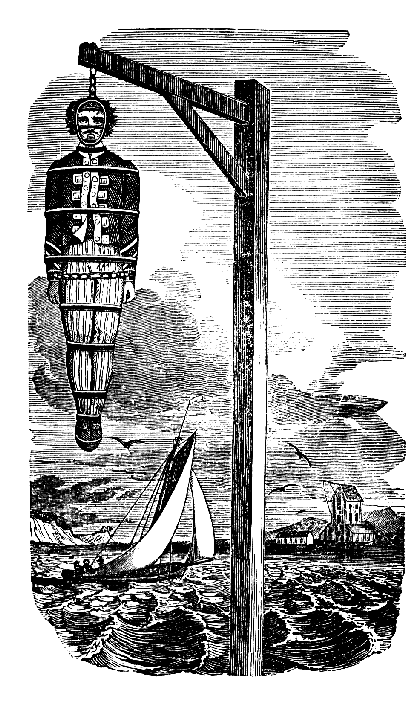 While pirates worked under a banner
of democracy,
there were times when they realized some actions
needed consequences so others wouldn’t follow suit.
(Much like society which sometimes hung the corpses
of pirates in gibbets
at key places where respectable seamen would see
what awaited them should they be foolish enough to
go on the account.) This was why breaking certain
rules earned dire punishments in their codes of
conduct. Bartholomew Roberts spelled out two
specific violations. While pirates worked under a banner
of democracy,
there were times when they realized some actions
needed consequences so others wouldn’t follow suit.
(Much like society which sometimes hung the corpses
of pirates in gibbets
at key places where respectable seamen would see
what awaited them should they be foolish enough to
go on the account.) This was why breaking certain
rules earned dire punishments in their codes of
conduct. Bartholomew Roberts spelled out two
specific violations.
VI. No
Boy or Woman to be allowed amongst them. If any
Man were found seducing any of the latter Sex,
and carry’d her to Sea, disguised, he was to
suffer Death.
VII. To Desert
the Ship, or their Quarters in Battle, was
punished with Death or Marooning. (Defoe,
212)
Three of John
Phillips’ articles spelled out death, although
they were more specific in detail.
2. If
any Man shall offer to run away, or keep any
Secret from the Company, he shall be maroon’d,
with one Bottle of Powder, one Bottle of Water,
one small Arm and Shot.
3. If any Man
shall steal any Thing in the Company, or game to
the Value of a Piece of Eight, he shall be
maroon’d or shot.
9. If at any
Time we meet with a prudent Woman, that Man that
offers to meddle with her, without her Consent,
shall suffer present Death. (Defoe, 342-343)
Those who suffered marooning
had two or three choices, depending on the islet
upon which they were abandoned. If the spot of land
was visible only at low tide, he might drown when
the tide came in. Or he might die after suffering
the agonizing pains of an empty belly and a parched
throat, even though he was surrounded by water.
There was always a slim chance he might survive, but
the odds were against him. If neither of these
alternatives appealed, he might shoot himself.
Some Asian pirates also adhered to a set of rules
that included death as a punishment:
When
captive women are brought on board, no one may
debauch them; but their native places shall be
ascertained and recorded, and a separate
apartment assigned to them in the ship; any
person secretly or violently approaching them
shall suffer death. (Antony, 114)
Whether such punishments
were actually meted out was another thing entirely.
Survival on a ship necessitated teamwork, so pirates
instituted and strictly adhered to another rule when
tempers grew short. If an argument devolved into a
fight, the quartermaster broke it up with the
reminder that as soon as they went ashore, the fight
would be resolved via a duel. Normally, the victor
was decided by first blood spilt, which didn’t
necessarily mean one man died. Such was not the case
when an argument ensued aboard Calico Jack’s boat
between two men, one of whom was the man Mary Read
loved.
It
happened this young Fellow had a Quarrel with
one of the Pyrates, and their Ship then lying at
an Anchor, near one of the Islands, they had
appointed to go ashore and fight, according to
the Custom of the Pyrates: Mary Read was
to the last Degree uneasy and anxious, for the
Fate of her Lover; she would not have had him
refuse the Challenge, because, she could not
bear the Thoughts of his being branded with
Cowardice; on the other Side, she dreaded the
Event, and apprehended the Fellow might be too
hard for him . . . in this Dilemma, she shew’d,
that she fear’d more for his Life than she did
for her own; for she took a Resolution of
quarrelling with this Fellow her self, and
having challenged him ashore, she appointed the
Time two Hours sooner than that when he was to
meet her Lover, where she fought him at Sword
and Pistol, and killed him upon the Spot.
(Defoe, 158)
Who Shall Be Captain? by Howard
Pyle, 1911
Mary Read Kills Her
Antagonist, 1837
Being Come to the Place of Duel, the
Englishman Stabbed the Frenchman in the Back by
Geroge Albert Williams, 1914
(Sources: Wikimedia
Commons, Charles
Ellms's The
Pirates Own Book, Dover's Pirates)
The
boatswain of another crew was disrespectful to
Captain John Evans and an argument ensued. Evans
insisted on satisfaction ashore, but his opponent
refused so Evans gave him a “hearty drubbing.” In
retaliation, the boatswain shot Evans in the head,
and then jumped overboard. Some of his mates pursued
the boatswain and dragged him back aboard the ship
to stand trial. The whole incident had taken so much
time that a gunner didn’t wish to waste any
additional time on the matter and, opting to deliver
justice himself, shot the boatswain.
Henry
Morgan also killed one of his men. A Frenchman
had challenged a buccaneer to a duel, but rather
than heed the traditional rules, the man stabbed the
Frenchmen with a sword while his back was turned.
Morgan rewarded such cowardice with hanging.
The very nature of their work meant pirates might
fall during battle, but they might not be killed
directly. Death could be a consequence of exploding
gunpowder, flying splinters, falling masts and
tackle, or overturning guns. While ship-to-ship and
hand-to-hand combat might kill a pirate, so could
just the act of boarding the prey when the two ships
were grappled together. A shipmaster, who sailed
with the French corsair René
Duguay-Trouin, was crushed after he fell
between the vessels. Captain Peter Harris, who
sailed with Bartholomew Sharpe, sustained wounds in
both legs as he tried to board a Spanish ship off
Panama in 1680.
But many pirates were killed from wounds sustained
in the fight. Bartholomew Roberts, for example, died
when grapeshot struck him in the throat after HMS
Swallow attacked his ships off the coast of
Africa in 1722.
He
settled himself on the tackles of a gun, which
one Stephenson, from the helm, observing, ran to
his assistance, and not perceiving him wounded,
swore at him, and bid him stand up, and fight
like a man; but when he found his mistake, and
that his captain was certainly dead, he gushed
into tears, and wished the next shot might be
his lot. They presently threw him overboard,
with his arms and ornaments on, according to the
repeated request he made in his lifetime . . .
(Pirate’s, 145)
 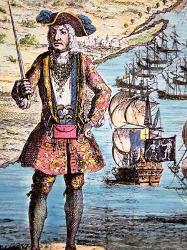
Nineteen of Roberts’s men, who were captured and
taken to Cape Coast
Castle, died either from their wounds or
diseases before they could be tried. One of those
men was Roger Ball, who, when asked how he came to
be badly burned, said, “Why John Morris fired a
pistol into the powder, and if he had not done it, I
would [have].” (Gosse, 44) Morris succeeded in
killing himself, but the attempt to blow up the ship
failed; yet Morris and Ball weren’t the only pirates
who would rather kill themselves than be captured.
What Morris attempted to do was what one pirate had
told the master of Samuel, captured in
August 1720, that they would do.
If we
are captured, we will set fire to the powder
with a pistol, and all go merrily to hell
together. (Botting, 165)
Other pirates of the
golden age also averred to perpetrate their own
demise rather than be captured. That sometimes meant
blowing up the ship, but other times it involved
killing each other. One example of the latter
involved two pirates who ritualized the vow:
[They]
took their Pistols, and laid them down by them,
and solemnly swore to each other, and pledg’d
the Oath in a Bumper of Liquor, that if they saw
that there was at last no possibility of
Escaping, but that they should be taken, they
would set Foot to Foot, and Shoot one another,
to Escape Justice and the Halter. (Rediker,
Villains, 149)
Captain Charles Harris
and his men preferred to “always [keep] a Barrel of
Powder ready to blow up the Sloop rather than be
taken.” (Rediker, Villains, 149) When they
encountered HMS Greyhound in 1723, one man
tried to ignite the keg, but “being hindered, he
went forward, and with his Pistol shot out his own
Brains.” (Rediker, Villains, 151) Joseph
Cooper’s crew, however, succeeded. When naval
officers attempted to board the ship, the pirates
blew themselves up.
Caesar,
who sailed with Edward
Thache (Blackbeard),
had tried to ignite the powder magazine on their
ship during Lieutenant Robert
Maynard’s surprise attack at Ocracoke Inlet
four years earlier. Two prisoners intervened, and
Caesar was taken into custody. Maynard’s account of
the fight simply reported:
I had
eight Men killed and 18 wounded. We kill’d 12,
besides Blackbeard, who fell with five Shot in
him, and twenty dismal Cuts in several Parts of
his Body. I took nine prisoners, mostly Negroes,
all wounded. (Cordingly, 176)
The
Boston News-Letter provided a more lurid
description of their fight three months later.
. . .
Maynard making a thrust, the point of his Sword
went against Teach’s Cartridge Box, and bended
it to the Hilt, Teach broke the Guard of it, and
wounded Maynard’s Fingers but did not disable
him. where upon he Jumpt back, threw away his
Sword and fired his Pistol, which wounded Teach.
Demelt struck in between them with his Sword and
cut Teach’s Face pretty much . . . one of
Maynard’s Men being a Highlander, ingaged Teach
with his broad Sword, who gave Teach a cut on
the Neck, Teach saying well done Lad, the
Highlander reply’d, if it be not well done, I’ll
do it better, with that he gave him a second
stroke, which cut off his Head, laying it flat
on his Shoulder, Teach’s Men being about 20, and
three or four Blacks, were all killed in the
ingagement . . . (British, I:295)
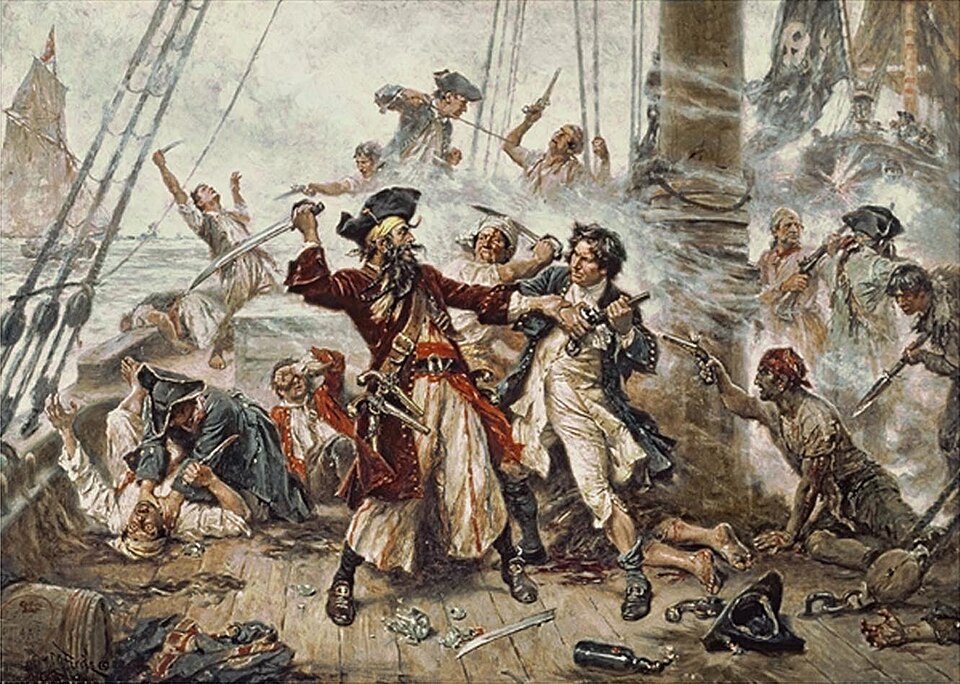 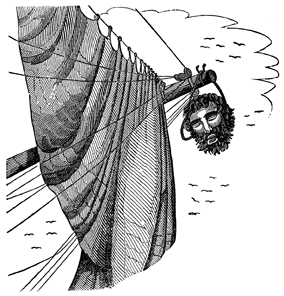
In all, Thache sustained twenty-five wounds. Maynard
had his corpse dumped over the side of the ship,
while he ordered the head hung from Jane’s
bowsprit.
Aruj
Barbarossa fell during a siege of Tlemcen in
1518. Forty-seven years later another Barbary
corsair died while attacking Malta. Turgut Reis
died doing what he enjoyed best – fighting
Christians. The English pirate Captain Parker was
killed in action against Dutch pirates at Marmora in
1611. Six years later, Basil Ringrose died when the
Spanish launched a surprise attack on the pirates in
Mexico. Fifty-four were killed in all and, according
to William
Dampier, their bodies were “stript, and so cut
and mangl’d, that he scarce knew one man.”4
(Preston, 132) In the middle of the 1700s, Captain William
Death engaged a French privateer. During the
battle, which lasted three hours, Death was killed.
Even retirement didn’t guarantee a peaceful life. Thomas Tew,
who lived in Rhode
Island, had made his fortune, but his men kept
trying to convince him to make one last voyage. It
took several years, but they finally succeeded in
1695.
They
prepared a small Sloop, and made the best of
their Way to the Straits, entering the Red
Sea, where they met with and attack’d a Ship
belonging to the Great Mogul; in the Engagement,
A Shot carry’d away the Rim of Tew’s
Belly, who held his Bowels with his Hands some
small Space; when he dropp’d, it struck such a
Terror in his Men, that they suffered themselves
to be taken without making Resistance.
(Defoe, 439)
Jean
Laffite (left) and Thomas Tew
with the governor by Howard Pyle, 1894 (right)
Sources: (unknown, Dover's Pirates)
Like many who received pardons for past crimes, Jean
Laffite resumed his pirating ways while
residing on Galveston
Island after the Battle of
New Orleans. In 1820, the United States Navy
drove him from that haven. Three years later, news
reports in various papers declared he had died
battling two Spanish warships. Jeff Modzelewski’s
translation of an article that originally appeared
in the Sunday, 20 April 1823, issue of Gaceta de
Columbia read:
The
Columbian corsair General Santander, of 43 tons,
at the command of Captain Jean Laffite, gave
chase at 5 in the morning on February 4, at 20
leagues beyond the Omoa tradewinds, opposite
Triumph of the Cross, to a brigantine and a
Spanish schooner, until 10 at night: the
brigantine, after an hour of combat, and at the
point of surrendering, signaled with lanterns to
the schooner, which immediately turned upon the
corsair: at this time Captain Laffite, mortally
wounded, stimulated the ardor of his crew and
turned over the command of the ship to his
second in command, who suffered the same fate.
Contramaestre [Chief petty officer or boatswain]
Francisco Similien, after the death of the
second in command, continued sustaining the
combat until one at night when, it being
impossible to continue it, changed course, as
did the two Spanish vessels, which doubtless
were very damaged by the fire of the corsair,
since they did not pursue its retreat: Captain
Laffite died from his injuries the next day . .
. .5
In the early eighteenth
century, pirates adopted common symbols denoting
death and placed them on their flags.
Skulls and crossed bones were frequently included on
gravestones in the sixteenth and seventeenth
centuries. Paintings of the period also included
allegorical symbols of death. To the pirates,
dancing skeletons were akin to the fate that awaited
them should they be caught (dancing the hempen jig).
Raised glasses denoted a toast to death, while
weapons warned that death awaited those who dared to
resist. Sandglasses and wings indicated how quickly
time passed. Regardless of the symbols decorating
their jacks, the pirates warned one and all that
death was a real possibility. Even before such flags
flew from ship masts, murder was part of this
criminal way of life.
Depictions
of Jolly Rogers displaying symbols connected to
death
Like other buccaneers of the seventeenth century,
the French flibustier Captain Daniel could
be particularly bloodthirsty when fighting enemies,
but he was also a pious man. While anchored off
Isles des Saintes, he asked a priest to celebrate
mass aboard his ship. The piety of one of his men
was less than expected, so Daniel shot him in the
head. Then Daniel told the priest, “Do not be
troubled, my father, he is a rascal lacking in his
duty and I have punished him to teach him better.”
(Gosse, 103) After mass ended, the flibustiers dumped
the body overboard.
Captain
Kidd also killed one of his own men, even
though that might not have been his intent; murder
would become one of the charges lodged against him
when he stood trial in 1701. The dispute arose
because Kidd refused to attack a Dutch ship.
Moor,
the gunner, being one day upon deck, and talking
with Kidd . . . some words rose betwixt them,
and Moor told Kidd, that he had ruined them all;
upon which, Kidd, calling him dog, took up a
bucket and struck him with it, which breaking
his skull, he died the next day. (Pirate’s,
62)
It was a ship’s crew and
passengers, as well as residents of towns, who paid
the ultimate sacrifice when pirates attacked. After
Edward
England assaulted the British
East India Company’s Cassandra
in July 1720, Captain James McRae
left this account.
. . .
many of my men were killed or wounded, and no
hopes left of us from being all murdered by
enraged barbarous Conquerors, I order’d all that
could, to get into the longboat under the cover
of the smoke of our guns, so that with what some
did in boats, & others by swimming, most of
us that were able reached ashoar by 7 o’clock.
When the Pyrates came aboard, they cut three of
our wounded men to pieces. I, with a few of my
people, made what haste I could to the
Kingstown, 25 miles from us, where I arrived
next day, almost dead with fatigue and loss of
blood, having been sorely wounded in the Head by
a musket ball. (Konstam, Scourge,
144)
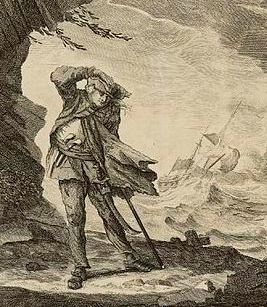 Edward
“Ned” Low was a brute when it came to his
victims. Sometime after he parted company with George
Lowther in 1722, Low fell in with a French
warship. He and his pirates “took all the crew out
of her, but the cook, who, they said, being a greasy
fellow would fry well in the fire; so the poor man
was bound to the main-mast, and burnt in the ship,
to the now small diversion of Low and his
mermidons.” (Pirate’s, 159) Edward
“Ned” Low was a brute when it came to his
victims. Sometime after he parted company with George
Lowther in 1722, Low fell in with a French
warship. He and his pirates “took all the crew out
of her, but the cook, who, they said, being a greasy
fellow would fry well in the fire; so the poor man
was bound to the main-mast, and burnt in the ship,
to the now small diversion of Low and his
mermidons.” (Pirate’s, 159)
Nor were western pirates the only ones who
slaughtered people. Pirates who prowled the waters
of South China often murdered some crew members on
the vessels they seized so the remainder would
submit to their demands. Others slew entire crews to
prevent them from talking. In April 1809, Guo
Lianghuo seized a boat off the Xiangshan coast. He
and his men garnered 550 taels of silver and stole
the cargo before trussing up their victims and
throwing them overboard. One of Xie Yaer’s captives
had the audacity to curse the pirate chief, who
smote the man into pieces and then fed these to the
fish. When Chen Lassan encountered similar defiance,
his men sliced the prisoner in half twice, severed
his limbs, and removed his heart and liver, which
the pirates soaked in wine and then ate.
Nor were men the only victims
who refused to submit. In 1809, pirates attacked the
village of Kan-shih in Guangdong, China.
Mei
ying, the wife of Ke choo yang was very
beautiful, and a pirate being about to seize her
by the head, she abused him exceedingly. The
pirate bound her to the yard-arm; but on abusing
him yet more, the pirate dragged her down and
broke two of her teeth, which filled her mouth
and jaws with blood. The pirate sprang up again
to bind her. Ying allowed him to approach but as
soon as he came near her, she laid hold of his
garments with her bleeding mouth and threw both
him and herself into the river where they were
drowned. (Bandits, 274)
A seaman for the British
East India Company, Richard
Glasspoole also found himself a prisoner of
ladrones (Chinese pirates) in September 1809. He
spent more than a month in captivity while waiting
for his ransom to be paid. After his release, he
published an account of his experiences:
The
ladrones were paid by their chief ten dollars
for every Chinamen’s head they produced. One of
my men, turning the corner of a street, was met
by a ladrone running furiously after a Chinese.
He had a drawn sword in his hand and two
Chinamen’s heads which he had cut off, tied by
their tails and slung round his neck. I was
witness myself to some of them producing five or
six to obtain payment!!! (Captured,
312)
Three years earlier, John Turner, another
Englishman, became a “guest” of Chinese pirates for
nearly six months. He witnessed an attack on an
Imperial Navy vessel and described the brutality
meted out to two officers. “One man had his feet
nailed to the deck and was beaten with rattan whips
until he vomited blood, ‘and after remaining some
time in this state, he was taken ashore and cut to
pieces.’ The other officer ‘was fixed upright, his
bowel cut open, and his heart taken out’.” Like Chen
Lassan’s victim, the pirates dined on that man’s
heart. (Antony, 116) Such acts of cannibalism had a
three-fold purpose. First, they demonstrated to the
Imperial Navy just how far the pirates were willing
to go when seeking revenge against anyone who stood
in their way. Second, dining on the hearts and
livers of their victims transferred the courage and
longevity of the slain to the pirates. Lastly,
participating in the act solidified the ties that
bound the pirates into a cohesive group whose power
and cruelty terrified other potential victims.6
Nor were attacks on warships any less gruesome four
decades later when Shap ’ng
Tsai prowled the waters off Guangdong and
Fujian, China.
[F]ive
war junks . . . were chased by six pirate boats,
which boarded them, put their crews to death,
and carried the commanders . . . on shore, where
a fire was kindled, and the unfortunate officers
were burnt alive. (Vallar, 39)
Even today, death
remains a threat to seamen who encounter pirates. In
December 1992, Baltimar
Zephyr was attacked in the Malacca
Strait. The captain and first mate were both
murdered. According to a news report, “A crewman
said that he and Mr. Pereja [the first mate] were
threatened by a man armed with a rifle and a pistol.
The pirates shot up the radar before taking Mr.
Pereja below, where [he] was shot dead in the
captain’s cabin. It is believed that Captain
Bashforth tried to barricade himself in a lavatory
before suffering the same fate.” (Bennett) Six years
later, Cheung
Son and twenty-three seamen disappeared.
Six crew members’ bodies eventually surfaced off
Shantou, China; they had been bound, gagged, and
wrapped in fishing nets that were weighted down. On
13 January 1999, Chinese authorities arrested the
pirates. Photographs were discovered showing them
celebrating the hijacking of and murders on Cheung
Son.
During the seventeenth century, some buccaneers were
particularly sadistic, especially when it came to
their treatment of Spaniards. Daniel
Montbars, whom some nicknamed “The
Exterminator,” liked to “cut open the stomach of his
victim, extract one end of his guts, nail it to a
post and then force the wretched man to dance to his
death by beating his backside with a burning log.”
(Cordingly, Under, 132) Gerrit Gerritszoon,
better known as Rock
Brasiliano, “perpetrated the greatest
atrocities possible against the Spaniards. Some of
them he tied or spitted on wooden stakes and roasted
them alive between two fires, like killing a pig –
and all because they refused to show him the road to
the hog-yards he wanted to plunder.” (Exquemelin,
80) Even worse was Jean David Nau (François
L’Olonnais). Headed toward San Pedro, he came
across Spanish soldiers waiting to ambush him;
instead he captured them.
Being
possessed of a devil’s fury, [he] ripped open
one of the prisoners with his cutlass, tore the
living heart out of his body, gnawed at it, and
then hurled it in the face of one of the others,
saying “Show me another way, or I will do the
same to you.” (Exquemelin, 107)
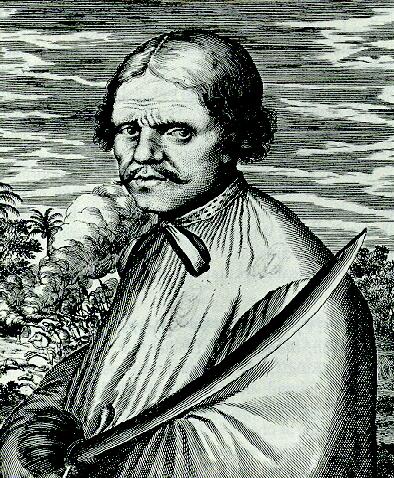 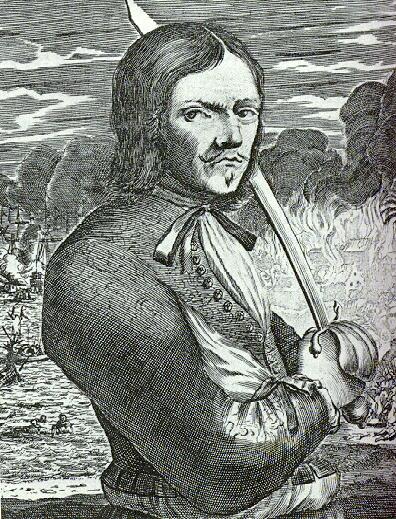
The French buccaneer Raveneau de Lussan recorded in
his journal
one incident where the ransom for his captives never
arrived. “We were forced to apply to our prisoners
the customary rigorous measures used to intimidate
our enemies – to have them throw dice to see which
men would lose their heads.” (Earle, 106) A few
months before his capture in 1714, Alexander Dalzel
and seven other pirates stole a French vessel while
in Le Havre. They “murdered the pylot with a dagger,
and tooke the master’s brother and tyed his hands
and legs and cast him off at sea.” (Earle, 66)
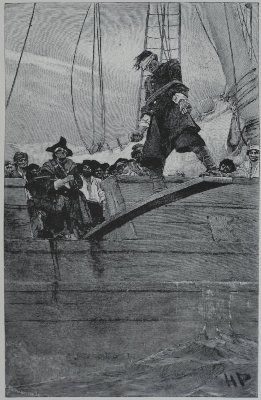 While
walking the plank was more fiction than reality,
there were a few instances where pirates employed
this technique to end their victims’ lives; none of
these occurred before the nineteenth century. The Niles
Weekly Register for 5 October 1822,
included an item that had originally appeared in the
Kingston Chronicle several months earlier. It
involved an attack on Blessing, a sloop out
of Jamaica. The pirate leader ordered a plank While
walking the plank was more fiction than reality,
there were a few instances where pirates employed
this technique to end their victims’ lives; none of
these occurred before the nineteenth century. The Niles
Weekly Register for 5 October 1822,
included an item that had originally appeared in the
Kingston Chronicle several months earlier. It
involved an attack on Blessing, a sloop out
of Jamaica. The pirate leader ordered a plank
. . .
run out in the starboard side of the schooner,
upon which he made captain Smith walk, and that,
as he approached to the end, they tilted the
plank, when he dropped into the sea, and there,
when in the effort of swimming, the captain
called for his musket, and fired at him
therewith, when he sank, and was seen no more!
(Pirate’s, 161)
An incident seven years
later involved pirates who captured a Dutch brig off
the coast of Cuba. After binding each man’s arms
together and blindfolding him, the pirates chained
round shot to the seamen’s feet. Then the pirates
forced them to walk off the ship into the sea.
Conversely, the victims of pirates sometimes struck
a blow against their attackers. When Howell
Davis visited Principe Island in the Gulf of
Guinea, he told the Portuguese governor he was a
pirate hunter. Rather than being duped, the governor
invited Davis to visit him for drinks. As the ten
pirates climbed the hill to the fort, the narrow
path forced them to walk single file. When they
reached a specific point, the soldiers who had lain
in wait for the pirates rose up and fired their
muskets. Howell sustained four wounds, one to his
stomach, but managed to stagger forward until
another bullet hit him. Before he died, he fired his
pistols at the Portuguese. William Snelgrave, a
captured merchant captain aboard the pirates’ ship,
ended his description of the event with “The
Portuguese, being amazed at his great strength and
courage, cut his throat that they might be sure of
him.” (Sanders, 53) Also killed in the attack were
the ship’s surgeon and two others.
L’Olonnais suffered a fitting death after all the
tortures he inflicted on victims. His last
expedition in 1668 was beset with bad luck. At the
mouth of the Nicaragua River:
He was
set upon both by the Indians and the Spaniards:
many of his men were killed and l’Olonnais and
the rest were forced to flee. L’Olonnais
determined not to return to his comrades on the
island without a ship. He held council with the
men still in his company and they resolved to
take the longboat along the coast of Cartagena
in an attempt to capture some vessel or other.
But now it
seems God would permit this man no further
wicked deeds, but was ready to punish him for
all the cruelties he had inflicted on so many
innocent people by a cruel death. On arrival in
the Gulf of Darien, he and his men fell into the
hands of those savages the Spaniards called
Indios Bravos. According to one of his
companions, who only saved himself from a like
fate by running away, l’Olonnais was hacked to
pieces and roasted limb by limb.
(Exquemelin, 117)
Death, of course, was
the usual punishment meted out to pirates who were
captured. They knew this, which may be why they
tended to “laugh in the face of death.” Bartholomew
Roberts and his men liked to raise this toast: "Damnation to him who ever
lived to wear a halter." (Rediker, Villains, 150)
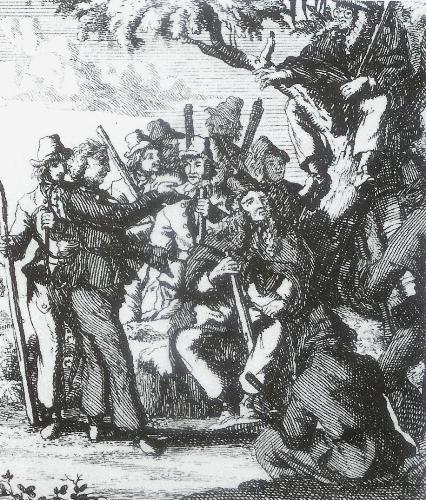 To
further show their disregard for justice and the
death sentence, pirates often held mock trials where
they would prosecute each other on charges of
piracy. One man played the judge, another the
prosecutor. Others served on the jury or adopted
less officious roles, such as a scribe, sheriff, or
witness. Of course, someone had to be the accused.
Like putting on a play, they donned makeshift
costumes that ridiculed the pomp and circumstance of
a real trial. To
further show their disregard for justice and the
death sentence, pirates often held mock trials where
they would prosecute each other on charges of
piracy. One man played the judge, another the
prosecutor. Others served on the jury or adopted
less officious roles, such as a scribe, sheriff, or
witness. Of course, someone had to be the accused.
Like putting on a play, they donned makeshift
costumes that ridiculed the pomp and circumstance of
a real trial.
Lacking a black robe, the judge “had a dirty
Tarpulin hung over his Shoulders.” Lacking a wig,
he stuck a thrum cap on his head. He put “a large
Pair of Spectacles on his Nose” and took his
exalted place up in a tree so as to look down on
the proceedings from a position above it all.
Scurrying around below were “an abundance of
Officers attending him,” comically using ship’s
tools, “Crows, Handspikes, &c. instead of
Wands, Tipstaves, and such like.” Soon “the
Criminals were brought out,” probably in chains,”
making a thousand sour Faces” as they entered the
outdoor courtroom. The attorney general “opened
the Charges against them.” (Rediker, Villains,
156-157)7
This parody scoffed at death and, by switching which
roles each pirate played from one day to the next,
they confused the proper order of society. Yet such
disdain also portended the future for some enemies
of all mankind.8
At one mock trial that Thomas
Anstis’s crew held on a cay off Cuba, George
Bradley, who played the judge, intoned the following
sentence on the prisoner:9
Then
heark’ee, you Raskal at the Bar; hear me,
Sirrah, hear me. – You must suffer for three
Reasons: First, because it is not fit I should
sit here as Judge, and no Body be hang’d. –
Secondly, you must be hang’d, because you have a
damn’d hanging Look: – And thirdly, you must be
hang’d, because I am hungry; for know, Sirrah,
that ’tis a Custom, that whenever the Judge’s
Dinner is ready before the Tryal is over, the
Prisoner is to be hang’d of Course. – There’s
Law for you, ye Dog. – So take him away Gaolor.
(Defoe, 293-294)
Captain Herdman, who
presided over the Vice-Admiralty Court passing
judgment on the pirates from Bartholomew Roberts’
ships, delivered a far different soliloquy in 1722.
Ye and
each of you are adjudged and sentenced to be
carried back to the place from whence you came,
from thence to the place of execution without
the gates of this castle, and there within the
flood marks to be hanged by the neck till you
are dead, dead, dead. And the Lord have mercy on
your souls. (Pirates, 7)
It took just three weeks
to try and execute those pirates sentenced to death.
One hundred sixty stood trial at Cape Coast
Castle that year. Twenty were sentenced to
seven years of hard labor in the Cape Coast mines,
and seventeen were sent to London to serve their
prison sentences in the Marshalsea
Prison. In an ironic twist of fate, some of
Bartholomew Roberts’s men once told the captured
Samuel’s master, “We shall accept no Act of Grace,
may the King and Parliament be damned with their act
of Grace for us, neither will we go to Hope Point
[Execution Dock] to be hanged a-sun-drying.”
(Botting, 165) Yet fifty-two did dance the hempen
jig, just not at that particular place. Instead,
they swung on the ramparts of Cape Coast Castle, and
eighteen were left to dry in the sun on one of three
prominent hills overlooking the water.10
Death by execution was the usual consequence for
those pirates whom authorities eventually captured.
Marcus Rediker estimated that “[b]etween 1716 and
1726, no fewer than 418 were hanged, and in truth
the actual number was probably one-third to one-half
higher.” (Rediker, Villains, 163) Executions
were the norm as far back as history records, but
hanging wasn’t always the means by which a pirate
bade a final farewell.
After the ransom was paid that freed Julius
Caesar, he returned to the Cilician
pirates’ lair and crucified them in 75 BC. On 24
August 1217, Hugh de Burgh finally caught Eustace the
Monk and gave him two choices: his beheading
could take place at the center or at the side of the
ship. Klaus
Störtebeker and his Likedeeler were captured
in 1401 and taken to Hamburg, Germany.11 All
seventy-two pirates were beheaded in October.
Supposedly, the executioner and Störtebeker reached
an agreement whereby the executioner would lop off
Störtebeker’s head first. Then his corpse would
traverse the ground where his men were aligned in a
row. At the point where the headless pirate finally
toppled over, any men he had passed (eleven in all)
would be pardoned. In reality, all were decapitated
and their heads crowned spikes along the waterfront.
Hamburg officials also executed another thirty-three
pirates, as well as their leader Klein
Henszlein, in 1573. Beheading was often the
punishment meted out to pirates in China and other
Asian countries, even as late as 1891 when the Namoa
pirates were put to death in Hong Kong.
Beheading of Eustace the Monk during
the Battle off Sandwich in 1217 by Matthew
Paris, 13th century
Beheading of Klaus
Störtebeker and his men
Execution of the Namoa Pirates on 11 May
1891 at Kowloon City, China
(Sources: Wikimedia
Commons, Pirate
Images, New
York Public Library)
Spain and her American colonies preferred to garrote
a pirate, strangling him with a rope that was
twisted either by hand or with the use of a cudgel
or stick. For example, after buccaneers raided
Tampico in the spring of 1684, three Spanish ships
pursued the pirates. They captured 104, whom they
took to Veracruz. Eleven were garroted, but one was
saved after the cord being twisted around his neck
broke not once, but twice. At this point a priest
intervened, saying, “This man has offered himself to
the Virgin, and God does not wish that he die.”
(Little, Buccaneer’s, 208)
Nor were such executions simple affairs, for the
Spanish imposed a ritualistic element to the
punishment. The night before a priest and pirate
would pray for the latter’s salvation until it was
nearly dawn. He was then expected to confess his
guilt before being conducted to the place of
execution where he was made to sit or he was tied to
a pole. After slipping a rope around his neck, the
executioner stood behind him and turned the cudgel
until the pirate died.
Hanging, however, was the most common form of
execution, especially in Britain
and her colonies. When Venetian galleys returned
home in the early 1600s, thirty-six English pirates
dangled from the yardarms. Before the golden age,
only a few pirates suffered the punishment of death,
and often these men were the ringleaders. That
changed as merchants became more powerful and
governments became less tolerant; authorities strove
to make the seas safer for merchants, travelers, and
seamen. “Between 1716 and 1726 . . . roughly one in
every ten pirates came to an end on the gallows . .
. .” (Rediker, Villains, 163) For example,
thirty-four pirates who followed Stede
Bonnet were hanged in 1718. Four years later,
Jamaica put Matteo Luque and forty-one of the
fifty-eight who followed him to death. In 1723,
twenty-five pirates were executed at Newport, Rhode
Island, six on Antigua, another twelve on Curaçao,
and two more in Bermuda. The previous year,
fifty-two men were hanged at Cape Coast
Castle. The governor of the castle, General
Phipps, said afterward:
We hope
the example that has been made of this gang will
be a means to affright and deter all others from
pursuing such vile practices on this coast and
that the trade thereby will be secured free and
undisturbed from the depredations of such
miscreants for some time to come. (Sanders,
238)12
After Calico Jack
Rackham captured the vessel on which Mary Read
served, Jack discussed the good life of a pirate, as
well as the “ignominious Death” Read might suffer if
caught and tried. She considered hanging “no great
Hardship.”
[W]ere
it not for that, every cowardly Fellow would
turn Pyrate, and so infest the Seas, that Men of
Courage must starve: – That if it was to the
Choice of the Pyrates, they would not have the
Punishment less than Death, the Fear of which
kept some dastardly Rogues honest; that many of
those who are now cheating the Widows and
Orphans, and oppressing their poor Neighbours,
who have no Money to obtain Justice, would then
rob at Sea, and the Ocean would be crowded with
Rogues, like the Land, and no Merchant would
venture out; so that the Trade, in a little
Time, would not be worth following. (Defoe,
158-159)
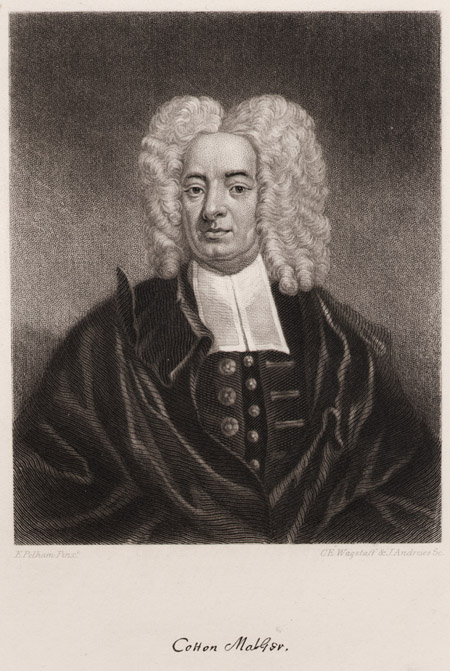 Hanging a pirate did not
just involve a guilty sentence and a rope around the
neck. To execute someone required rituals, which
unfolded once a pirate was condemned to die.
Ministers, such as Paul Lorrain and Cotton
Mather, talked with the prisoners in hopes of
getting them to confess and repent. Lorrain, the Ordinary at
Newgate, visited William
Kidd twice a day. While Surgeon Atkins tried
to get the pirates who had followed Bartholomew
Roberts to apologize for their wicked crimes, he was
told, “We are poor rogues and so must be hanged,
while others, no less guilty in another way,
escaped.” (Botting, 175) Hanging a pirate did not
just involve a guilty sentence and a rope around the
neck. To execute someone required rituals, which
unfolded once a pirate was condemned to die.
Ministers, such as Paul Lorrain and Cotton
Mather, talked with the prisoners in hopes of
getting them to confess and repent. Lorrain, the Ordinary at
Newgate, visited William
Kidd twice a day. While Surgeon Atkins tried
to get the pirates who had followed Bartholomew
Roberts to apologize for their wicked crimes, he was
told, “We are poor rogues and so must be hanged,
while others, no less guilty in another way,
escaped.” (Botting, 175)
On the Sunday before the scheduled hanging, the
minister preached an execution sermon with the
condemned present in the congregation. Finally, the
fateful day arrived, and how each pirate comported
himself varied from one man to another. Sometimes
providing false courage to a pirate was essential in
conveying the prisoner from jail to the site of his
execution. The procession to Wapping’s
Execution Dock, a distance of three miles,
took at least two hours.
. . .
yet the Courage that strong Liquors can give,
wears off, and the Way they have to go is
considerable, they are in Danger of recovering.
. . . For this reason they must drink as they
go; and the Cart stops for that Purpose three or
four, and sometimes half a dozen Times, or more,
before they come to their Journey’s End.
(Zacks, 388)
William Kidd was already
drunk when he left Newgate
Gaol in 1701, and even more so by the time he
arrived at Wapping.
Other times, the pirates required no such
sustenance. When Dennis Macarty arrived at his place
of execution, blue ribbons decorated his neck,
wrists, knees, and hat. He told the crowd, “Some of
my friends said I should die in my shoes. To make
’em liars, I kicks them off.” (Downie, 28) Then he
did just that. Thomas Morris’s ribbons were red. Charles
Gibbs “was dressed in a blue roundabout
jacket, and blue trowsers and white cap, the jacket
bearing on the left arm the figure of an anchor
worked with white ribbon . . . .” (Gibbs, 144) As
Christopher Sympson passed through the crowd of
people who gathered to witness the hangings at Cape
Coast Castle, he saw Elizabeth Trengrove, a former
captive, and declared, “I have lain with that bitch
three times and now she has come to see me hanged.”
(Botting, 175)
The first six of Roberts’s pirates to hang were the
most irascible and stubborn of his men. According to
Atkins:
They all
exclaimed against the severity of the court, and
were so hardened as to curse, and wish the same
justice might overtake all the members of it, as
had been dealt to them . . . . [They walked] to
the gallows without a tear . . . showing as much
concern as a man would express at travelling a
bad road. (Sanders, 239)
Pirates never ascended
the gallows alone; they were accompanied by men of
the cloth and the executioner, who placed the noose
around each pirate’s neck. In exchange for executing
Kidd, the hangman received £1 for each pirate hanged
that day and one shilling six pence for each noose
he provided.
The sheriff or marshal read aloud the execution
order. It was expected the condemned would confess
to the wrong path he had taken, tell the gathered
crowd he deserved to be hanged, and then seek God’s
forgiveness for his sins. He might also impart a
final message or words of wisdom at this juncture. Walter
Kennedy followed the “script” in uttering his
final words on 19 July 1721:13
I am
brought to this Place of Shame and Disgrace for
Crimes which fully deserve so vile a death, and
I freely confess my self guilty of the Crimes I
was convicted of, as well as many other Faults
of the like Nature, for which I beg the Pardon
of God, and of you my Countrymen . . . (Pirate’s,
127)
John Augur, who hadn’t
shaved or taken a bath at least since his capture
and was clad in tattered clothes, showed only
remorse when he drank a glass of wine and wished
Governor Woodes
Rogers much success in curbing piracy.
Others failed to adhere to “scripted” expectations.
Thomas Morris grinned and declared that his only
wish was that he could have been a greater plague
than he had been. Captain Richard Thomas declared:
“Yes, I repent that I had not done more mischief,
and that we did not cut the throats of them that
took us, and I’m extremely sorry that you ain’t
hanged as well.” (Downie, 28)
Some straddled both sides, first repenting and then
changing their minds. According to a pamphlet
published after John
Quelch’s death, “[t]he last Words he spake to
One of the Ministers at his going up the Stage, were
I am not afraid of Death, I am not afraid of the
Gallows, but I am afraid of what follows; I am
afraid of a Great God, and a Judgment to come.” But
a short time later, his attitude changed.
“Gentlemen, ’Tis but little I have to speak: What I
have to say is, I desire to be informed for what I
am here, I am condemned only upon Circumstances. I
forgive all the World: So the Lord be Merciful to my
Soul.” The minister admonished the crowd not to pay
heed to Quelch’s words, to which he responded: “They
should also take care how they brought Money into
New-England, to be Hanged for it!” (Pirate’s,
67-68)
Once the noose was tightened, the minister prayed. After
the hangman fitted a noose around Kidd’s neck,
Paul Lorrain sang a psalm. One example was Psalm 51,
often referred to as the “Miserere.” The first two
verses of which are:
Have
mercy on me, O God, according to thy steadfast
love;
According to
thy abundant mercy blot out my transgressions.
Wash me
thoroughly from my iniquity, and cleanse me from
my sin! (The Holy Bible, Revised
Standard Edition)
Gallows of the period
differed from the scaffold with a trap door that we
commonly associate with a hanging. In Kidd’s day,
two poles supported a wooden beam and a raised
platform. Steps or a ladder provided access to the
platform, while the rope dangled from the horizontal
beam. The plank would be yanked away and the men
would drop. Alternative options were to have the
condemned stand in a cart or on a barrel or ladder.
The cart would be driven out from under the person,
or the prisoner was turned or pushed off the
pedestal.
Following a final prayer, the hangman did his job.
Someone gave Stede Bonnet a farewell nosegay, which
he still clutched after the cart he stood upon
rolled away and he dropped at White Point
in Charleston, South Carolina in December
1718. Kidd was turned off and dangled in the
air, but the rope snapped and he dropped into the
mud. Once again, the executioner bundled him up a
ladder, fitted another noose around his neck, and
then pulled the ladder away. Kidd did not escape
death a second time.
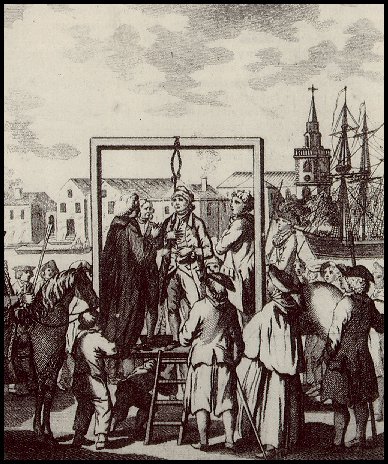 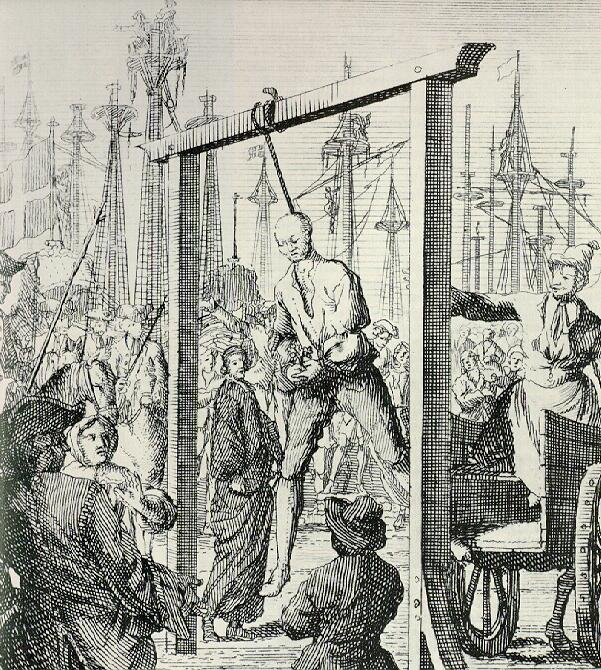
Hanging of a buccaneer
at Execution Dock by unknown artist of the
17th century
Execution of Major Stede
Bonnet from the 1725 Dutch version of Captain
Charles Johnson's A General History of the
Pyrates
(Sources: Wikimedia
Commons, Pirate
Images)
In October 1821, Charles
Gibbs, whose real name was James D. Jeffers,
found himself a prisoner of the United States Navy.
Before his capture, he had hacked off the limbs of
the captain of one captured ship. Another one was
torched with her entire crew still alive and on
board. After an untimely escape, Gibbs eventually
danced the hempen jig on 22 April 1831, a decade
after he was first caught. So many came to Ellis
Island to watch the execution that some had to
remain in their boats, one of which capsized and a
man drowned. Gibbs calmly walked to the west side of
the island, betraying “no marks of terror, although
it was evident that he shrunk from death. When first
brought out, he surveyed the gallows with an anxious
eye, but seemed satisfied that there was no avoiding
his fate.” (Gibbs, 145) When he was ready, he let go
of his handkerchief, and the hangman chopped the
cord that held two fifty-six-pound weights, which
violently snatched the condemned prisoner from the
scaffold. After he was pronounced dead, his body was
delivered “to Doctor John Augustine Smith, Professor
of Anatomy, in the college of Physicians and
Surgeons of the University of the State of New York”
for dissection. (Gibbs, 147)
Although hangings garnered large crowds and often
had a festive air about them, the actual act was far
from entertaining. The dying man’s neck did not
snap, rather he might take an agonizing forty-five
minutes to die of suffocation. His face became
purple. His legs jigged. His kidneys and bowels
relieved themselves. If relatives or friends of the
pirate were present, they might pull on his legs to
hasten his demise.
It was a tradition to publicly display the bodies of
the more notorious pirates as a warning to those
foolish enough to follow in the pirate’s footsteps.
The bodies of Calico Jack Rackham and two of his men
were hung in chains at Plumb Point, Bush Key, and
Gun Key on Jamaica.
After the tide had washed over Kidd’s body three
times, his corpse was retrieved, coated with tar,
and bound in chains. Then the blacksmith at Tilbury
stuffed it into a metal harness so he could hang it
up at Tilbury Point.14
No definitive time was given as to how long his
bones would be on display, but some accounts gave
the length as “for years.”
Kidd wasn’t the only pirate to be hanged twice. As John Gow “was turned
off, he fell down from Gibbet, the rope breaking by
the weight of some that pulled his leg. Although he
had been hanging for four minutes, he was able to
climb up the ladder a second time, which seemed to
concern him very little, and he was hanged again.”
(Gosse, 140-141) After his execution on 11 June
1725, they hung his body in chains at Greenwich.
An alternative to hanging a body in a gibbet was to
display just the deceased’s head on a spike in a
prominent location, often along the waterfront. This
happened to Pierre L’Orange after his execution in
Veracruz on 22 October 1683.
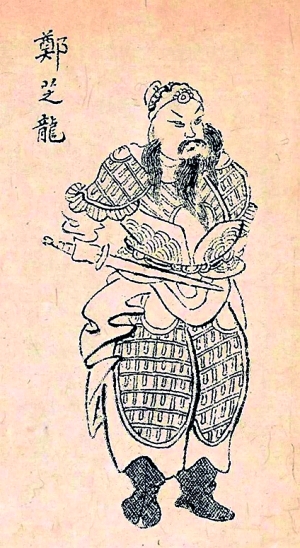 While
the normal punishment for pirates in Imperial China
was beheading, Zheng
Zhilong (Christian name Nicholas Iquan) might
have suffered a torturous death in 1661. Regents for
the Emperor of Hearty Prosperity (Manchu or Qing
dynasty) ordered him to be slowly sliced to death.
This involved making a thousand cuts to a person’s
extremities in a progressively inward fashion. Each
slice was cauterized to stem the bleeding and to
inflict additional pain. Before Zheng died, he would
also watch his torturers inflict the same punishment
on two of his sons.15 While
the normal punishment for pirates in Imperial China
was beheading, Zheng
Zhilong (Christian name Nicholas Iquan) might
have suffered a torturous death in 1661. Regents for
the Emperor of Hearty Prosperity (Manchu or Qing
dynasty) ordered him to be slowly sliced to death.
This involved making a thousand cuts to a person’s
extremities in a progressively inward fashion. Each
slice was cauterized to stem the bleeding and to
inflict additional pain. Before Zheng died, he would
also watch his torturers inflict the same punishment
on two of his sons.15
The last pirate hanged during the golden age of
piracy was Olivier
Levasseur (also known as La Buse or The
Buzzard), who was turned off on the beach at Bourbon
Island in the Indian Ocean in July 1730. The
attending crowd cheered as the deed was done.
Even today, execution remains a real possibility
when hunting pirates. After Somali pirates captured
Maersk
Alabama and took Captain Richard
Phillips hostage, U. S. Navy
SEAL snipers shot three pirates on 12 April
2009.
Some pirates defied the odds and lived past their
prime, dying of either natural causes or from old
age. Thomas Paine’s last piratical voyage began in
1708 when he was seventy-six years old. Sometime
after his return to New England, he was interred on
his estate in Connecticut. Philip Gosse, the pirate
historian, attempted to track down pirate
tombstones, but only succeeded in finding one that
was located in a cemetery in Dartmouth, England.
While Queen Anne sat on the throne, Captain Thomas
Goldsmith went a pirating and amassed quite a
fortune before he died in his bed in 1714. The
following inscription adorned his headstone:
Men that are virtuous serve the Lord;
And the Devil’s by his friends ador’d;
And as they merit get a place
Amidst the bless’d or hellish race;
Pray then ye learned clergy show
Where can this brute, Tom Goldsmith, go?
Whose life was one continual evil
Striving to cheat God,
Man and Devil.
(Gosse, 25)
|
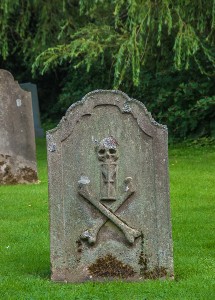
|
Some pirates, who
turned aside from their nefarious pursuits, lived
productive lives until their deaths. Lionel
Wafer, a surgeon, died around 1705. His fellow
buccaneer William Dampier died on Colman Street in
London a decade later. Sometime after Lancelot
Blackburne retired, he returned to England and
became the Archbishop of York. When he passed away
on 23 March 1743, it was “a time of extreme cold.”
(Marley, Pirates, 1:48) He was laid to rest
at St. Margaret’s in Westminster. Red Legs
Greaves became a philanthropist, giving to
charities and public institutions. His death was
greatly mourned. Edward England, on the other hand,
lived an extremely impoverished life on Madagascar
before he passed away in 1720.
The fourth governor of French Saint-Domingue, Bertrand
D’Ogeron, Sieur de la Bouère, led buccaneers
on a disastrous raid to Puerto Rico in 1673. He
eventually returned to Paris, where on 21 January
1676, he died at the Sorbonne of “an incurable
diarrhea.” (Marley, Pirates, 1:298)
Although better known for his support of Charles II
in his bid to regain the throne of England, Prince Rupert of
the Rhine also participated in a bit of
plundering. In 1653, his fleet wrecked during a
storm near the Virgin Islands; his brother Maurice
died when his ship went down. Broken in spirit from
these losses, Rupert returned to England. He died in
his bed at Spring Gardens in 1682.
Perhaps the most famous buccaneer to die of natural
causes was Sir Henry Morgan. He succumbed to dropsy,
a result of being “much given to drinking and
sitting up late,” according to his physician. At the
time, he owned several properties in Jamaica and was
worth over £5,000. Captain Lawrence Wright of HMS
Assistance wrote in his journal in August
1688:
Saturday
25. This day about eleven hours noone Sir Henry
Morgan died, & the 26th was brought over
from Passage-fort to the King’s house at Port
Royall, from thence to the Church, & after a
sermon was carried to the Pallisadoes &
there buried. All the forts fired an equal
number of guns, wee fired two & twenty &
after wee & the Drake had fired, all the
merchant men fired. (Gosse, 227)
The most powerful pirate
of China spent her last days “leading a peaceful
life so far as [was] consistent with the keeping of
an infamous gambling house.” (Murray, 150) Zheng Yi
Sao (Cheng I Sao) negotiated her own
retirement in April 1810, receiving amnesty from the
Imperial Chinese government and keeping much of her
plunder. She died in 1844, at the age of sixty-nine
in Canton, China.
Benjamin Johnson tortured many of his victims until
they died. When he attacked the town of Busrah, he
slew the sheik and most of the residents before
returning to the Sultan of Ormus with the hold of
his ship laden with diamonds, pearls, and gold. At
an island on the edge of the Persian Gulf, he
slaughtered 2,000 priests; all but one out of 700
dancing girls had their noses cut off and their
upper lips split. He spared the most beautiful one
this ordeal only to abduct her. He also stole
treasure amounting to 5,000,000 rupees. On the way
home, he plundered an East Indiaman from England and
killed her crew. At some point, he decided he no
longer wished to serve the Sultan of Ormus. Stealing
his master’s fastest ship, into which he stowed
enormous wealth amounting to £800,000, he sailed to
Constantinople, where he became a bashaw. Although
many lost their lives by his hand, he lived a long
life and died naturally.
A few pirates’ deaths were out of the ordinary.
Thomas Hawkins, who had sailed with Thomas Pound,
was reprieved after a sentence of death and sent to
England in 1690. He never arrived; during the
voyage, the ship encountered a French privateer, and
Hawkins was killed. In 1723, George
Lowther was found dead on the Isle of Blanco
of a gunshot wound. His pistol lay beside him. That
same year, Thomas
Anstis forced several men to join his crew. To
pay him back, they murdered him in his hammock while
he slept. After his retirement, Thomas Howard went
to India and married, only to be murdered by her
relatives.
Nathaniel
North of Bermuda retired to Madagascar, where
a native slew him. To avenge his death, North’s
friends waged a private war on the tribe for seven
years. Charles Swan was slain by Philippine natives.
Captain Pedro de Castro’s ship wrecked at Punta
Brava. While the majority or his men were either
killed by natives or died of starvation, he and
thirty-five others cooked “the cut-up corpses in the
stewpot . . . without wasting even the heads.”
(Little, Buccaneer’s, 209) Only two men ever
returned from the ordeal.
Blas Miguel
and Pasqual Anan were broken on the wheel in 1687,
an excruciating death practiced by the French.
Benerson Little described it in The Buccaneer’s
Realm:
. . . the
condemned was bound with his arms and legs
outstretched, often to a wheel although this was
not necessary. In the West Indies a cross was
sometimes used upon a scaffold . . . . Father
Labat witnessed one such execution: the condemned
mounted the scaffold, kneeled, prayed, then
undressed and stretched out on the cross. With a
hammer the executioner then broke each of the long
bones in the condemned man’s arms and legs several
times. If the condemned was fortunate, a priest
might cover his face with a handkerchief . . . as
Labat once did. The executioner ended the agony –
if the condemned was not already dead from the
trauma – by strangling him with a rope, first
permitting a priest to ask the condemned for a
last act of contrition. (211)
 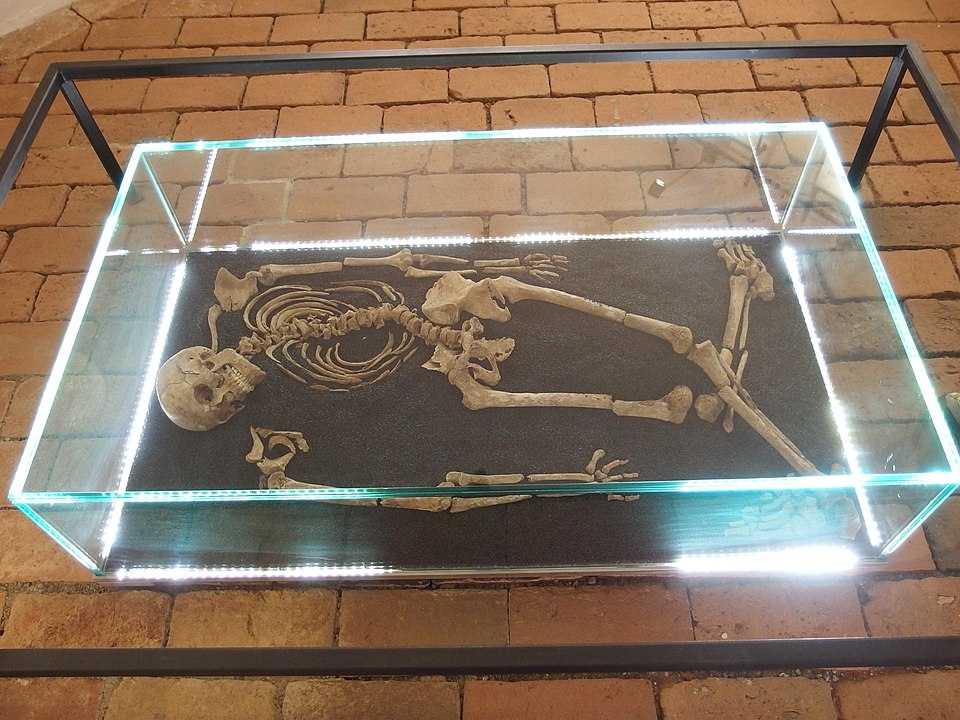
Breaking wheels used at
execution in Cologne in 1589 (left) and
effects of such an execution on a 25- to
30-year-old man circa 17th century (right)
(Sources: Wikimedia
Commons, Wikimedia
Commons)
Afterwards, the two
pirates’ heads were displayed atop the gallows where
the bodies of forty-two of their dead comrades had
been hanged the day before on Petit Gouave.
Manual
Boyga, one of the pirates who sailed on Panda,
was sentenced to hang in June 1835. The night before
his execution, he tried to commit suicide by cutting
himself with a piece of tin. Too weak to stand
because of the loss of blood, he was hanged while
sitting in a chair.
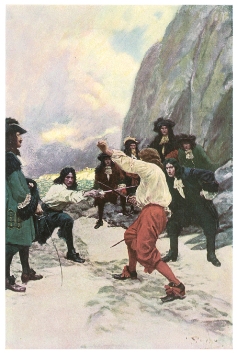 Although
Nikolaas
van Hoorn succumbed from natural causes, the
manner in which he contracted gangrene was unusual.
His animus rivalry with fellow Dutch vrijbuiter
Laurens de Graaf came to a head after the
sacking of Veracruz in May 1683, while they waited
for ransoms to be paid for their Spanish hostages.
In the ensuing duel, “Van Hoorn drew his blade and
advanced on his countryman . . . .” (Marley, Pirates,
1:389) De Graaf drew his weapon and said, “Voilà!
Here is what will avenge the injury you had given
me.” (Little, Buccaneer’s, 190) Similar to
the fictional duel between Captains Blood and
Levasseur in Rafael Sabatini’s Captain
Blood, their swords clashed on the beach
of Sacrificios Island. “De Graaf . . . drove his own
sword deep into Van Hoorn’s wrist, then kicked his
disabled opponent into the sand. His wrath now fully
aroused, De Graaf bellowed at his men to haul his
bloodied opponent aboard his flagship and clap him
in irons.” (Marley, Pirates, 1:389) Everyone
assumed it was a slight cut, a wound that would
quickly heal. Instead, the wound festered, and van
Hoorn succumbed on 24 June 1683, off Isla Mujeres.
His body was interred in an unmarked grave near Cape
Logrete in Mexico. Although
Nikolaas
van Hoorn succumbed from natural causes, the
manner in which he contracted gangrene was unusual.
His animus rivalry with fellow Dutch vrijbuiter
Laurens de Graaf came to a head after the
sacking of Veracruz in May 1683, while they waited
for ransoms to be paid for their Spanish hostages.
In the ensuing duel, “Van Hoorn drew his blade and
advanced on his countryman . . . .” (Marley, Pirates,
1:389) De Graaf drew his weapon and said, “Voilà!
Here is what will avenge the injury you had given
me.” (Little, Buccaneer’s, 190) Similar to
the fictional duel between Captains Blood and
Levasseur in Rafael Sabatini’s Captain
Blood, their swords clashed on the beach
of Sacrificios Island. “De Graaf . . . drove his own
sword deep into Van Hoorn’s wrist, then kicked his
disabled opponent into the sand. His wrath now fully
aroused, De Graaf bellowed at his men to haul his
bloodied opponent aboard his flagship and clap him
in irons.” (Marley, Pirates, 1:389) Everyone
assumed it was a slight cut, a wound that would
quickly heal. Instead, the wound festered, and van
Hoorn succumbed on 24 June 1683, off Isla Mujeres.
His body was interred in an unmarked grave near Cape
Logrete in Mexico.
Captain Hiram
Breakes retired to Amsterdam, only to discover
that his wife had been executed after murdering
their son. Overwhelmed with melancholy, he jumped
into a dyke and drowned. Captain Samuel
South Burgess was an old man when his drink
was poisoned. Joseph Thwaites, a renegado who
sailed out of Algiers, retired to New York City. He
died in 1797, after being bitten by a rattlesnake.
Thomas
Veale escaped from an English jail to hide out
in the cave where he had hidden his treasure and
from which he worked as a cordswainer. In 1658, an
earthquake caused rocks to seal the entrance. Since
he was never seen after this, it was presumed he was
in the cave when this occurred.
The fates of Henry Every
and Anne Bonny
are unknown; they simply disappear from the
historical record. During the most prolific period
of piracy, 1716 through 1726, the demise of only
fifty-five pirate captains is known: twenty-six are
hanged, six die while in battle, four drown when
their ships are lost, four are murdered by their own
men, one commits suicide, one is set adrift, and one
lives in poverty until he dies. The twelve others
retire from their plundering ways.
As is true of all people from the beginning of time,
even pirates die. Despite all the information in
this article, the simple fact is that the final days
of many is a mystery. Either the historical artifact
recording their deaths has been destroyed or lost,
or the manner of their deaths was never recorded in
a way that ties them to their roguish past. They
remain as nameless as some of their innocent
victims.
Notes:
1. Some accounts say that
Hornigold was either killed during a battle with
two Spanish ships, or he was captured and rotted
in a Cuban prison for the rest of his life.
Whatever the reality, he vanished.
2.
Pascoe Thomas, who taught mathematics aboard
Commodore George Anson’s Centurion,
contracted scurvy and developed hard nodes and
black spots “till almost my legs and thighs were
as black as a negro; and this accompanied with
such excessive pains in the joints of the knees,
ankles and toes . . . . It next advanced to my
mouth; all my teeth were presently loose, and my
gums, over-charged with extravasated blood, fell
down almost quite over my teeth; this occasioned
my breath to stink much.” (Cordingly, Pirate,
54-55) The affliction killed almost sixty-six
percent of Anson’s crew.
3.
One pirate who was partially pickled was Nicholas
Brown. When John Drudge sailed into Jamaica in
November 1726, his vessel carried a keg of rum.
Inside was Brown’s head, which Drudge exchanged
for £500.
4.
According to Dampier, Ringrose “had no mind to
this voyage; but was necessitated to engage in it
or starve.” (Preston, 132)
5.
This translation appeared in correspondence
exchanged on the Laffite Society Discussion Group
in September 2001. Jeff has held several offices
within The Laffite Society and has a B.A. and M.A.
in Spanish. He also studied in Madrid for two
years.
6.
This magic ritual was outlawed during the Qing
dynasty. Violators were sentenced to
death-by-slicing. The condemned was secured to a
cross, then cut into 24, 36, 72, or 120 pieces.
(The specifics of the least number of cuts can be
found on page 116 of Antony’s book.) Not only did
this person suffer, but so did his or her family,
even if they never participated in the
cannibalistic ritual. The relatives were banished
for the rest of their lives.
7.
A General History of the Pyrates includes
an example of a mock trial. It can be found in the
chapter about Captain Anstis. In the edition cited
below, the transcript appears on pages 292 through
294.
8.
The pirates tried in these mock trials were never
actually hanged. Only once did that happen.
Whether they were too drunk to realize what was
happening, “[o]n one occasion, after a playful
trial, a pirate was convicted, sentenced to death,
and amid the laughter of his comrades, the
sentence was carried out.” (Bandits, 225)
9.
Bradley was eventually captured and sentenced to
death by a judge in Bermuda in June 1723.
10.
The oldest pirate to hang at Cape Coast Castle was
forty-five years old. The youngest was nineteen.
The last batch was executed on 20 April 1722.
11.
Likedeeler translates into English as
those who shared all possessions and plunder.
12.
The hangings at Cape Coast Castle were done in
groups during a two-week period in April 1722.
Gibbets were erected on the surrounding hills that
overlooked the harbor and the tarred bodies of
eighteen of the pirates were displayed. Although
others were not sentenced to be hanged, their
sentences resulted in death. Of the seventeen who
were transported to London, only four actually
arrived there. The rest died at sea. Not one of
the twenty men sent to work in the Royal Africa
Company’s mines for seven years survived until the
end of their sentences.
13.
Once a trusted man in Bartholomew Roberts’s crew,
William Kennedy appropriated the pirates’ plunder
and went out on his own. In England, he opened a
brothel, where he was eventually recognized and
one of the women reported this information to the
authorities, who promptly arrested him. After a
stint in Marshalsea Prison, he was hanged at
Wapping in London.
14.
The metal harness that encased Kidd’s body cost
£10. In contrast, after John Rose Archer and
William White were hanged in June 1724, the cost
to make the chains to hold Archer and to affix the
corpse to the gibbet was £12 10 shillings. The
price to ferry his and White's bodies, as well as
for the laborers who erected the gibbet and buried
White, came to £3 15 shillings and 8 pence.
15.
On the day of execution, the emperor decreed that
the Zhengs would be beheaded instead.
To learn more, I recommend the following resources:
Abbott,
Geoffrey. The Book of Execution: An
Encyclopedia of Methods of Judicial Execution.
Headline, 1994.
Antony, Robert J. Like
Froth Floating on the Sea: The World of Pirates
and Seafarers in Late Imperial South China.
University of California, 2003.
Bandits at Sea: A
Pirates Reader edited by C. R. Pennell. New
York University, 2001.
Beal, Clifford. Quelch’s
Gold: Piracy, Greed, and Betrayal in Colonial
New England. Praeger, 2007.
Bennett, Will.
“Captain’s Death Linked to Piracy: Inquest Verdict
Rejects Claims by Indonesian Authorities that Crew
Mutinied,” The Independent 27 July 1993.
Botting, Douglas. The
Pirates. Time-Life Books, 1978.
British Piracy in
the Golden Age: History and Interpretation,
1660-1730 edited by Joel H. Baer (4
volumes). Pickering & Chatto, 2007.
Burl, Aubrey. Black
Barty: The Real Pirate of the Caribbean.
Sutton, 2006.
Cabell, Craig, Graham
A. Thomas, and Allan Richards. Captain Kidd:
The Hunt for the Truth. Pen & Sword,
2010.
Captured by
Pirates: 22 Firsthand Accounts of Murder and
Mayhem on the High Seas edited by John
Richard Stephens. Fern Canyon Press, 1996.
Choundas, George. The
Pirate Primer: Mastering the Language of
Swashbucklers and Rogues. Writer’s Digest,
2007.
Clements, Jonathan. Coxinga
and the Fall of the Ming Dynasty. Sutton,
2005.
Clifford, Barry. Expedition
Whydah: The Story of the World’s First
Excavation of a Pirate Treasure Ship and the Man
Who Found Her. Cliff Street Books, 1999.
Clifford, Barry, and
Kenneth J. Kinkor. Real Pirates: The Untold
Story of the Whydah from Slave Ship to
Pirate Ship. National Geographic, 2007.
Cook, Gordon C. Disease
in the Merchant Navy: A History of the Seamens’
Hospital Society. Radcliffe, 2007.
Coote, Stephen. Drake:
The Life and Legend of an Elizabethan Hero.
Thomas Dunne, 2003.
Cordingly, David. Pirate
Hunter of the Caribbean: The Adventurous Life of
Captain Woodes Rogers. Random House, 2011.
Cordingly, David. Under
the Black Flag: The Romance and the Reality of
Life Among the Pirates. Random House, 1995.
Defoe, Daniel. A
General History of the Pyrates edited by
Manuel Schonhorn. Dover, 1999.
Downie, Robert. The
Way of the Pirate. ibooks, 1998.
Duffus, Kevin P. The
Last Days of Black Beard the Pirate. Looking
Glass Productions, 2008.
Earle, Peter. The
Pirate Wars. Thomas Dunne, 2003.
Eastman, Tamara J.,
and Constance Bond. The Pirate Trial of Anne
Bonny and Mary Read. Fern Canyon Press,
2000.
Gibbs, Joseph. Dead
Men Tell No Tales: The Lives and Legends of the
Pirate Charles Gibbs. University of South
Carolina, 2007.
Gosse, Philip. The
Pirate’s Who’s Who: Giving Particulars of the
Lives and Deaths of the Pirates and Buccaneers.
Rio Grande Press, 1924.
Gottschalk, Jack A.,
and Brian P. Flanagan. Jolly Roger with an
Uzi: The Rise and Threat of Modern Piracy.
Naval Institute Press, 2000.
Harvie, David. Limeys:
The True Story of One Man’s War against
Ignorance, the Establishment and the Deadly
Scurvy. Sutton, 2005.
Konstam, Angus. Blackbeard:
America’s Most Notorious Pirate. John Wiley
& Sons, 2006.
Konstam, Angus. Scourge
of the Seas: Buccaneers, Pirates and Privateers.
Osprey, 2007.
Konstam, Angus. The
World Atlas of Pirates. Lyons Press, 2010.
Little, Benerson. The
Buccaneer’s Realm: Pirate Life on the Spanish
Main, 1674-1688. Potomac Books, 2007.
Little, Benerson. The
Sea Rover’s Practice: Pirate Tactics and
Techniques, 1630-1730. Potomac Books, 2005.
Marley, David F. Pirates
of the Americas (2 volumes). ABC-Clio, 2010.
Marley, David F. Modern
Piracy. ABC-Clio, 2011.
Murray, Dian H. Pirates
of the South China Coast 1790-1810.
Stanford, 1987.
The Pirate’s
Pocket Book edited by Stuart Robertson.
Conway, 2008.
Pirates: Terror on
the High Seas from the Caribbean to the South
China Sea. Turner, 1996.
Preston, Diana and
Michael. A Pirate of Exquisite Mind: Explorer,
Naturalist, and Buccaneer – The Life of William
Dampier. Walker & Co., 2004.
Rediker, Marcus. Between
the Devil and the Deep Blue Sea: Merchant
Seamen, Pirates, and the Anglo-American Maritime
World, 1700-1750. Cambridge University,
1987.
Rediker, Marcus. Villains
of All Nations: Atlantic Pirates in the Golden
Age. Beacon, 2004.
Rogers, Woodes. A
Cruising Voyage Round the World: The Adventures
of an English Privateer. The Narrative
Press, 2004.
Sanders, Richard. If
a Pirate I Must Be . . . : The True Story of
“Black Bart,” King of the Caribbean Pirates.
Skyhorse, 2007.
Vallar, Cindy. “The
Chinese Pirate Who Battled the Royal Navy,” History
Is Now June 2014, pages 36-43.
Woodard, Colin. The
Republic of Pirates: Being the True and
Surprising Story of the Caribbean Pirates and
the Man Who Brought Them Down. Harcourt,
2007.
Zacks, Richard. The
Pirate Hunter: The True Story of Captain Kidd.
Hyperion, 2002.
Review
Copyright ©2014 Cindy Vallar
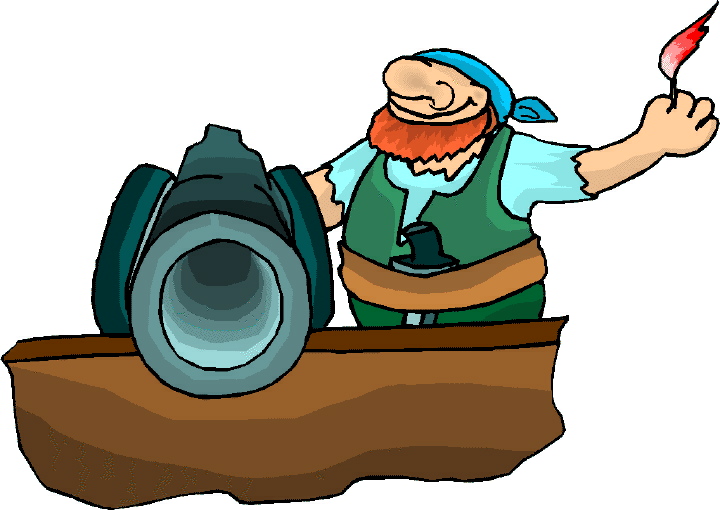
Click to contact me
Background image compliments
of Anke's Graphics |

